What’s New in SAFe 5.0?
SAFe Summit: A Whirlwind Tour of SAFe 5.0

On behalf of the entire Scaled Agile team and the SAFe Contributors, we are delighted to announce a preview of SAFe® 5.0 for Lean Enterprises, which introduces the Seven Core Competencies of the Lean Enterprise necessary to achieve true business agility.
We’re now in the age of software—an interconnected, real-time world where every industry is powered by technology and every company is, at least in part, a software company. Organizations that master Business Agility are the ones that will thrive—not just survive. Business Agility happens when the entire organization uses Lean and Agile practices to continually and proactively deliver innovative business solutions faster than the competition. This new release is designed to expand SAFe to encompass the entire enterprise and enable business agility.
Below are the highlights of the What’s New in SAFe 5.0. Click here to read our SAFe 5.0 FAQ on training, certification, and more. Download the What’s New in SAFe 5.0 presentation.
New Big Picture
As you can see from the SAFe Home page, SAFe 5.0 has a new Big Picture with an improved look and feel. Figure 1 shows the Full SAFe configuration with the key changes highlighted with red boxes.

New Business Agility
Business Agility is the ability to compete and thrive in the digital age by quickly responding to market changes and emerging opportunities with innovative business solutions. It requires that everyone involved in delivering solutions—business and technology leaders, development, IT operations, legal, marketing, finance, support, compliance, security, and others—use Lean and Agile practices to continually deliver innovative, high-quality products and services faster than the competition.
SAFe offers a way for enterprises to focus on customers, products, innovation, and growth by organizing a second operating system (Figure 2) around value streams instead of departments. This model, which Kotter calls a ‘dual operating system,’ restores the speed and innovation of the entrepreneurial network while leveraging the benefits and stability of the hierarchical system.

New SAFe Overview
A new overview tab (Figure 3) on the home page illustrates SAFe’s seven core competencies that enable business agility. This graphic provides a simplified view of SAFe’s Seven Core Competencies of the Lean Enterprise and their twenty-one dimensions that enable business agility.
The execution-related competencies are shown the left, while the competencies that support strategy development are on the right. The Lean-Agile Leadership competency which is the foundation is in the bottom middle. The customer is prominently featured at the center as the focal point for all the competencies. Measure and Grow at the top right is a reminder of the importance of periodic self-assessments to track the organization’s progress towards the principles and practices that enable business agility.
Moreover, this overview is a useful tool for providing an initial orientation to SAFe, as well as an introduction to the business agility assessment, and for framing conversations with senior leaders.

Measuring Business Agility
The new Measure and Grow article describes how to measure the state of business agility and how to accelerate growth to improve overall economic outcomes. Portfolio leaders and the Lean-Agile Center of Excellence (LACE), now have a way to self-assess their progress on this journey.

Two new Competencies
SAFe 5.0 introduces two new competencies, Continuous Learning Culture, and Organizational Agility. Each is briefly described next.
1. Continuous Learning Culture
 The Continuous Learning Culture competency describes a set of values and practices that encourage individuals—and the enterprise as a whole—to continually increase knowledge, competence, performance, and innovation. This culture is achieved by becoming a learning organization, committing to relentless improvement, and promoting a culture of innovation.
The Continuous Learning Culture competency describes a set of values and practices that encourage individuals—and the enterprise as a whole—to continually increase knowledge, competence, performance, and innovation. This culture is achieved by becoming a learning organization, committing to relentless improvement, and promoting a culture of innovation.
This new article describes the three dimensions of a continuous learning culture:
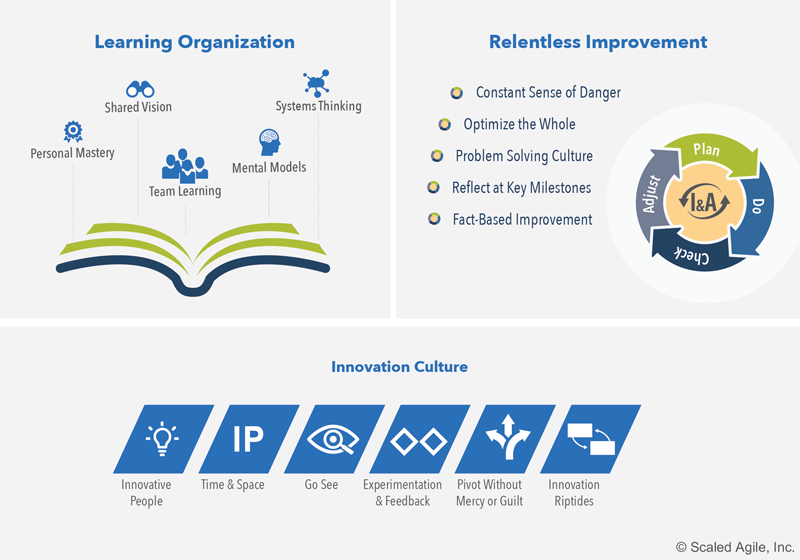
-
-
-
- Learning Organization – Employees at every level are learning and growing so that the organization can transform and adapt to an ever-changing world.
- Innovation Culture – Employees are encouraged and empowered to explore and implement creative ideas that enable future value delivery.
- Relentless Improvement – Every part of the enterprise focuses on continuously improving its solutions, products, and processes.
-
-
2. Organizational Agility
 The Organizational Agility competency describes how Lean-thinking people and Agile teams optimize their business processes, evolve strategy with clear and decisive new commitments, and quickly adapt the organization as needed to capitalize on new opportunities.
The Organizational Agility competency describes how Lean-thinking people and Agile teams optimize their business processes, evolve strategy with clear and decisive new commitments, and quickly adapt the organization as needed to capitalize on new opportunities.
This new article describes the three dimensions of organizational agility:
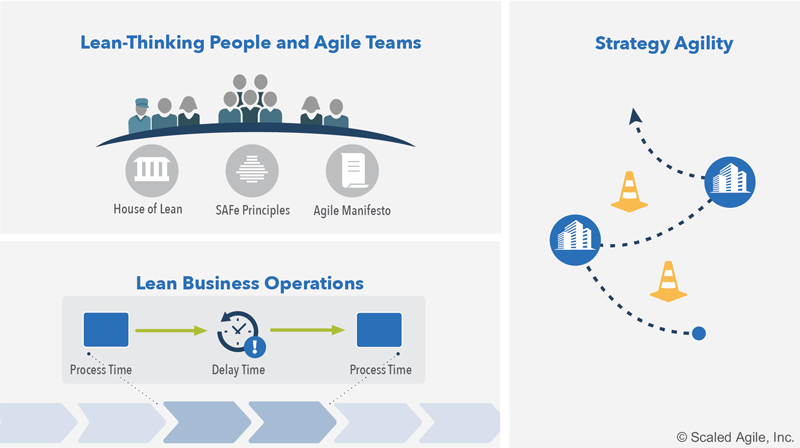
-
- Lean-Thinking People and Agile Teams – Everyone involved in solution delivery is trained in Lean and Agile methods and embraces and embodies the values, principles, and practices.
- Lean Business Operations – Teams apply Lean principles to understand, map, and continuously improve the business processes that support the businesses products and services.
- Strategy Agility – The enterprise is Agile enough to continuously sense the market, and quickly change strategy when necessary.
Five Restructured Competencies
1. Team and Technical Agility
The Team and Technical Agility competency describes the critical skills and Lean-Agile principles and practices that high-performing Agile teams and Teams of Agile teams use to create high-quality solutions for their customers. The result is increased productivity, better quality, faster time-to-market, and predictable delivery of value.
This competency has been rewritten and is now organized into the following dimensions:
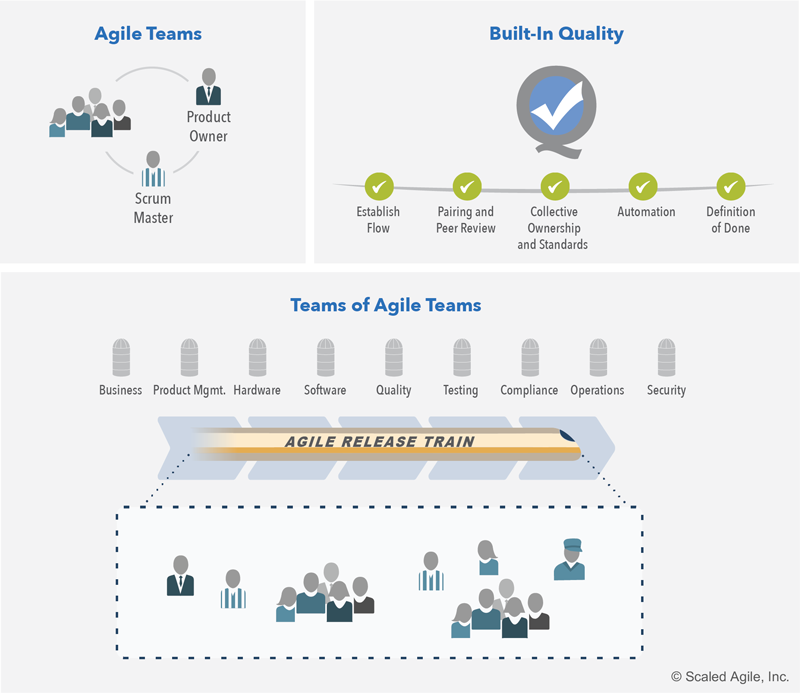
-
- Agile Teams – High-performing, cross-functional teams anchor the competency by applying effective Agile principles and practices.
- Team of Agile Teams – Agile teams operate within the context of a SAFe Agile Release Train (ART), a long-lived, team of Agile teams that provides a shared vision and direction and is ultimately responsible for delivering solution outcomes.
- Built-in Quality – All Agile teams apply defined Agile practices to create high-quality, well-designed solutions that support current and future business needs.
2. Agile Product Delivery
 The Agile Product Delivery competency is a customer-centric approach to defining, building, and releasing a continuous flow of valuable products and services to customers and users. This competency enables the organization to provide solutions that delight customers, lower development costs, reduce risk, and outmaneuver the competition. The DevOps and Release on Demand competency has been incorporated into two dimensions of the Agile Product Delivery competency as illustrated in Figure 8.
The Agile Product Delivery competency is a customer-centric approach to defining, building, and releasing a continuous flow of valuable products and services to customers and users. This competency enables the organization to provide solutions that delight customers, lower development costs, reduce risk, and outmaneuver the competition. The DevOps and Release on Demand competency has been incorporated into two dimensions of the Agile Product Delivery competency as illustrated in Figure 8.

-
- Customer Centricity and Design Thinking – Customer centricity puts the customer at the center of every decision and uses design thinking to ensure the solution is desirable, feasible, viable, and sustainable.
- Develop on Cadence; Release on Demand – Developing on cadence helps manage the variability inherent in product development. Decoupling the release of value assures customers can get what they need when they need it.
- DevOps and the Continuous Delivery Pipeline – DevOps and the Continuous Delivery Pipeline creates the foundation that enables Enterprises to release value, in whole or in part, at any time to meet customer and market demand.
3. Lean Portfolio Management
 The Lean Portfolio Management competency aligns strategy and execution by applying Lean and systems thinking approaches to strategy and investment funding, Agile portfolio operations, and governance. These collaborations give the enterprise the ability to align strategy to execution, to meet existing commitments reliably, and to better enable innovation.
The Lean Portfolio Management competency aligns strategy and execution by applying Lean and systems thinking approaches to strategy and investment funding, Agile portfolio operations, and governance. These collaborations give the enterprise the ability to align strategy to execution, to meet existing commitments reliably, and to better enable innovation.
This competency has been rewritten and is now organized into the following dimensions:

-
- Strategy & Investment Funding ensures the entire portfolio is aligned and funded to create and maintain the solutions needed to meet business targets.
- Agile Portfolio Operations coordinates and supports decentralized program execution and fosters operational excellence.
- Lean Governance is the oversight and decision-making of spending, audit and compliance, forecasting expenses, and measurement.
4. Enterprise Solution Delivery
 The Enterprise Solution Delivery competency describes how to apply Lean-Agile principles and practices to the specification, development, deployment, operation, and evolution of the world’s largest and most sophisticated software applications, networks, and cyber-physical systems.
The Enterprise Solution Delivery competency describes how to apply Lean-Agile principles and practices to the specification, development, deployment, operation, and evolution of the world’s largest and most sophisticated software applications, networks, and cyber-physical systems.
The Business Solutions and Lean Systems Engineering competency has been renamed to Enterprise Solution Delivery and expands its guidance to include the following new dimensions:

-
- Lean Solution and Systems Engineering applies Lean-Agile practices to align and coordinate all the activities necessary to specify, architect, design, implement, test, deploy, evolve, and ultimately decommission these systems.
- Coordinating Trains and Suppliers coordinates and aligns the extended, and often complex, set of value streams to a shared business and technology mission. It uses the coordinated Vision, Backlogs, and Roadmaps with common Program Increments (PI) and synchronization points.
- Continually Evolve Live Systems ensures large systems, and their development pipeline supports continuous delivery.
5. Lean-Agile Leadership
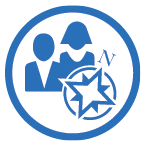 The Lean-Agile Leadership competency describes how Lean-Agile Leaders drive and sustain organizational change by empowering individuals and teams to reach their highest potential. They do this through leading by example, adopting a Lean-Agile mindset, and lead the change to a new way of working. The result is more engaged employees, increased productivity and innovation, and successful organizational change.
The Lean-Agile Leadership competency describes how Lean-Agile Leaders drive and sustain organizational change by empowering individuals and teams to reach their highest potential. They do this through leading by example, adopting a Lean-Agile mindset, and lead the change to a new way of working. The result is more engaged employees, increased productivity and innovation, and successful organizational change.
The Lean-Agile leadership article was rewritten and is now organized into the following dimensions:

-
- Leading by Example – Leaders gain earned authority by modeling the desired behaviors for others to follow, inspiring them to incorporate the leader’s example into their own personal development journey.
- Mindset and Principles – By embedding the Lean-Agile way of working in their beliefs, decisions, responses, and actions, leaders model the expected norm throughout the organization.
- Leading Change – Leaders lead (rather than simply support) the transformation by creating the environment, preparing the people, and providing the necessary resources to realize the desired outcomes.
Customer Centricity and Design Thinking
The customer article has been renamed to Customer Centricity, and the guidance has been expanded to focus on the mindset and impact of customer centricity. This article should be read with the Design Thinking article, which focuses on the tools and practices of implementing design thinking in support of customer centricity.
Customer Centricity
The foundation of the customer-centric enterprise is market and user research (Figure 12) that creates actionable insights into the problems customers face, the solution requirements, and the solution context.

Design Thinking
The new Design thinking (Figure 13) article represents a profoundly different approach to product and solution development, in which divergent and convergent techniques are applied to understand a problem, design a solution, and deliver that solution to the market.

Design thinking also inspires new ways to measure customer success:
- Desirable: Do customers and users want the solution?
- Feasible: Can we deliver the right solution through a combination of build, buy, partner, or acquire endeavors/activities?
- Viable: Is the way we build and offer the solution creating more value than cost? For example, in a for-profit enterprise, are we profitable?
- Sustainable: Are we proactively managing our solution to account for its expected product-market lifecycle?
SAFe for Business Teams
The enterprise’s business teams (Figure 14) are now ‘on the train’ and participate in delivering and supporting innovative business solutions. They also adopt the Lean and Agile values, principles, and practices that are relevant to their responsibilities and adjust their existing processes accordingly.

Principle #10 – Organize Around Value
SAFe Principle #10 – Organize around value (Figure 15) guides enterprises to align their development efforts around the full, end-to-end value flow. It introduces a ‘dual operating system’ (Figure 2), which leverages the benefits of a hierarchy, but also provides a network directly organized around value. SAFe’s network of value streams organizes the people who need to work together, increase quality, and minimizes delays and handoffs.

SAFe House of Lean
The SAFe House of Lean graphic has been updated to reflect the new guidance provided in the new and revised core competencies. The more significant changes are highlighted in red (Figure 16). See the Lean-Agile Mindset article for more information.
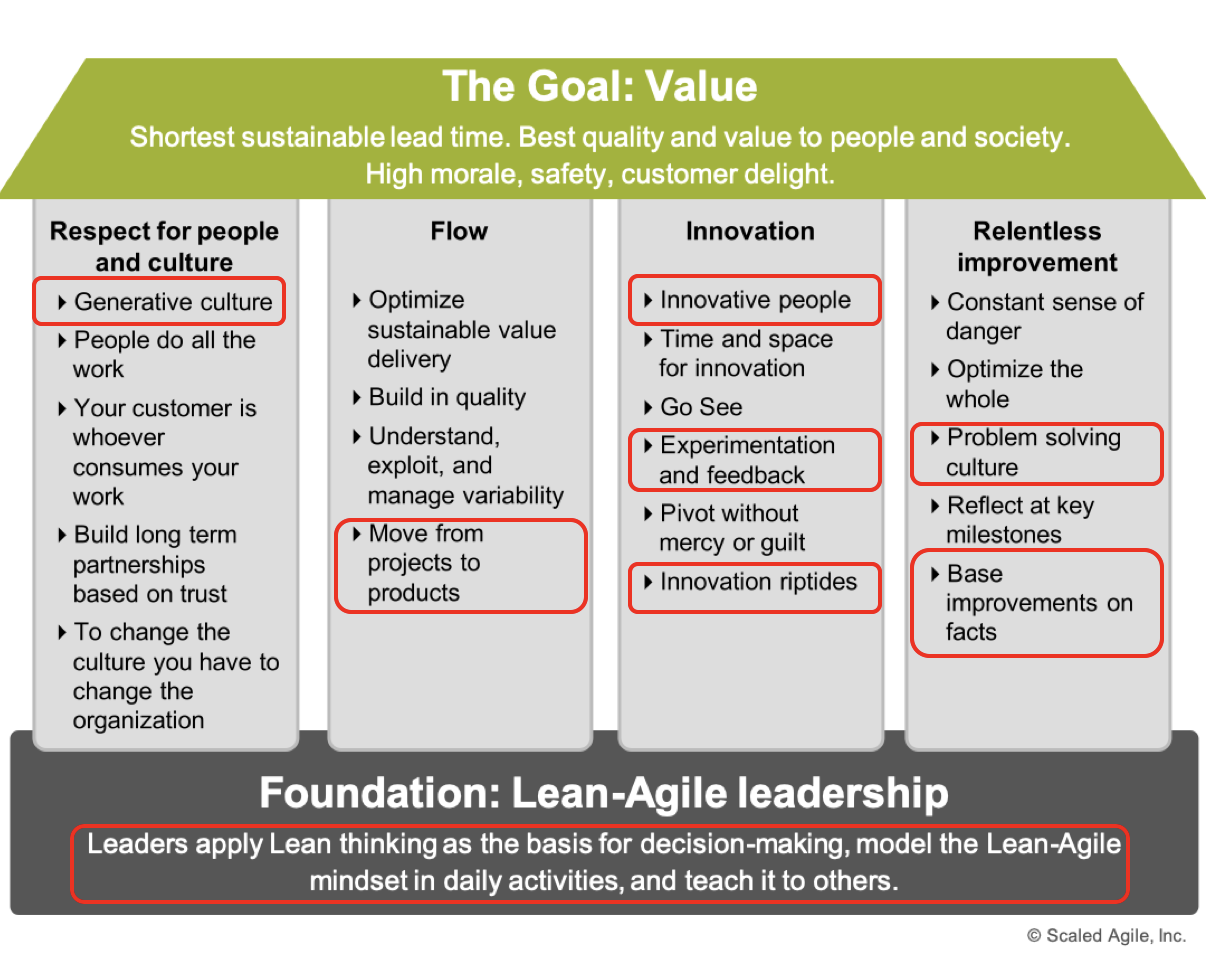
New SAFe Implementation Roadmap
The SAFe Implementation Roadmap has been updated to include two new courses (Figure 17). Additional changes are also highlighted by the red boxes and are described next.

Other changes include:
- The Sustain and Improve step has been renamed to Accelerate. This new article focuses on how to accelerate the organization toward business agility, including a list of ‘pro tips’ and advanced concepts for each of the seven core competencies.
- There is a new Measure and Grow icon and article that offers a method to evaluate the portfolio’s progress towards business agility and determine the next steps for growth.
Configuration Changes
SAFe’s four out-of-the-box configurations have been updated to reflect the new look and feel of the 5.0 release. The SAFe for Lean Enterprises article provides an overview of all the new SAFe 5.0 configurations.
Last update: 15 October 2019



